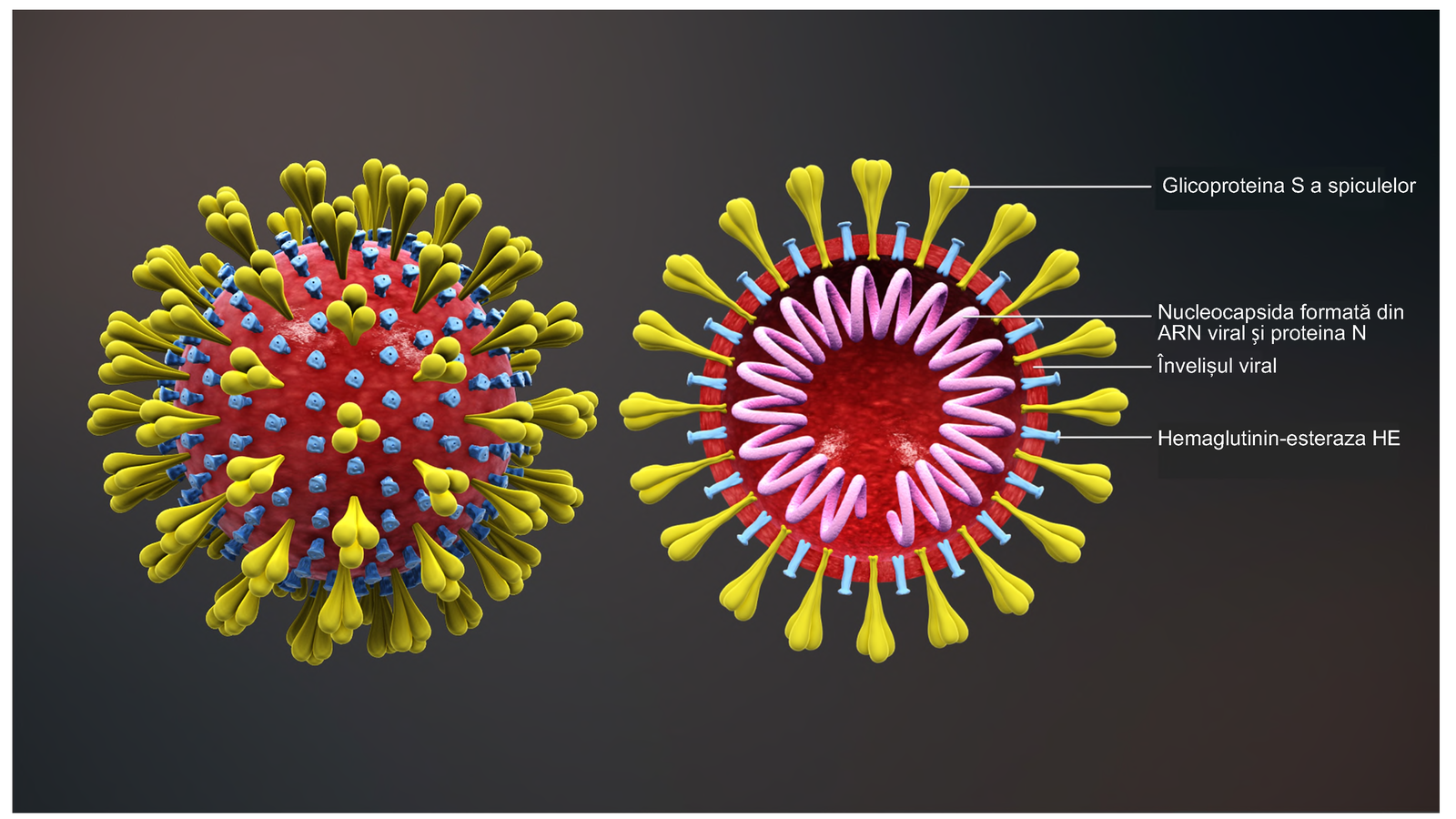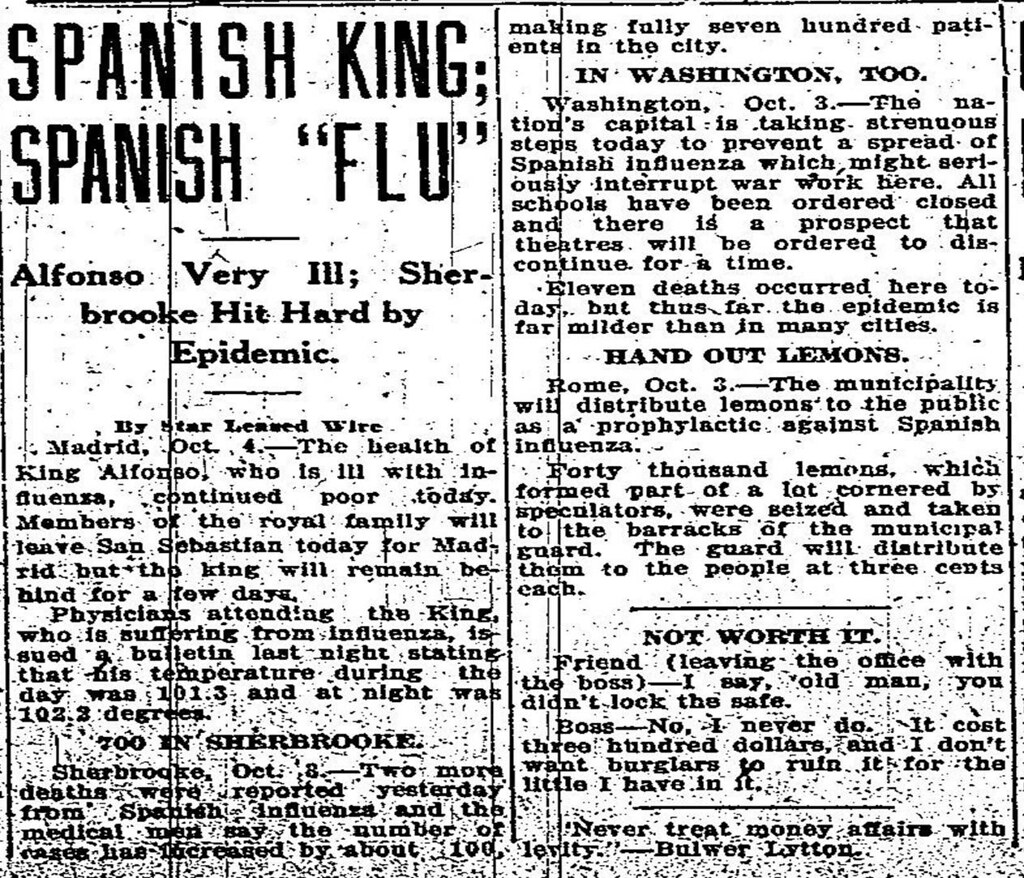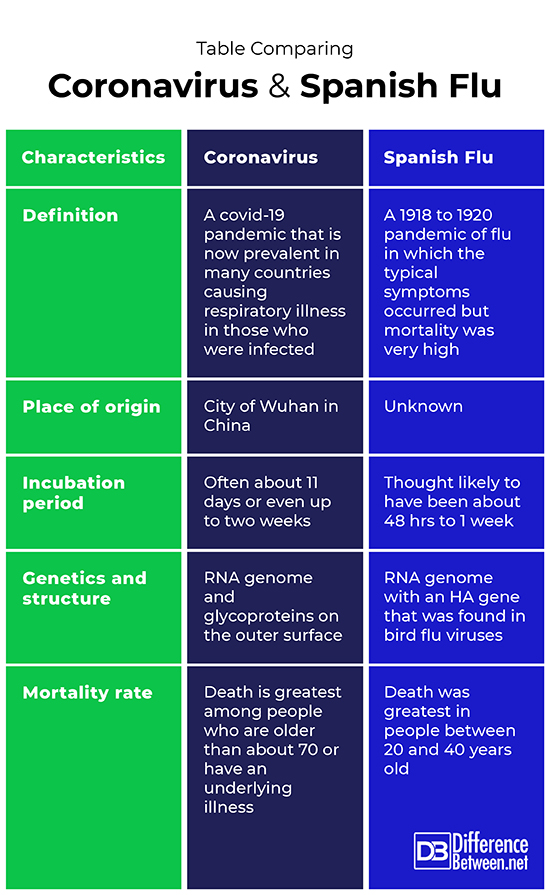Difference Between Coronavirus and Spanish Flu
Coronavirus or covid-19 is a current pandemic in which a respiratory illness is afflicting several people in many different countries. The Spanish flu was a pandemic that took place between 1918 and 1920 and caused millions of people to die.

What is Coronavirus?
Definition:
Coronavirus or covid-19 is a pandemic in which a virus is causing respiratory illness and resulting in death at a higher rate than the usual seasonal flu.
Genetics and origin of the coronavirus:
The coronavirus, covid-19, appears to have arisen first in China where the virus moved from an animal to a human. There is still debate on exactly which host animal the virus came from. It is a single-stranded RNA virus that has glycoproteins on the outermost surface; it has been found to be similar to the SARS coronavirus.
Symptoms and complications
The most notable and obvious symptoms of covid-19 infection are a high fever along with a dry cough. Unfortunately, the virus can lead to significant lung damage in some people causing major problems with breathing. This leads to poor oxygenation of the blood causing multiple organ failure or heart problems. Death rates vary according to age and state of health, but sometimes young healthy people do succumb.
Diagnosis:
An RT-PCR test can be done on a sample obtained from a person. There are now drive-through testing centers in some countries where people can drive up and have a sample taken for testing. The test works by looking for the specific genetic code of the virus, which then confirms the diagnosis.
Transmission:
The coronavirus, covid-19, is thought to be a zoonosis which was transmitted inadvertently from some animal host into humans. Human to human transmission then occurred.
Risk factors and mortality:
Risk factors include mixing with infected individuals, but it takes a while for symptoms to show. Health workers are also at high risk while treating covid-19 patients. This is why social distancing, where possible, has been implemented in many countries to reduce the contact between people. The greatest deaths are amongst people older than 70 years and who have other illnesses. Having underlying illnesses such as diabetes and heart disease does appear to increase the risk of complications and death from covid-19.
Treatment:
Symptoms are treated using pain killers and in some cases, the individual may need fluids due to dehydration caused by the fever, and supplemental oxygen due to lung problems. In very severe cases the person may need to be on a ventilator to assist breathing.

What is Spanish Flu?
Definition:
Spanish flu was a form of influenza that occurred from 1918 to 1920 and was a pandemic that caused many deaths.
Genetics and origin of the Spanish flu:
There has been much debate on where this flu came from originally, however, scientists believe it is likely it evolved from similar mammalian flu viruses but had acquired the hemagglutinin HA gene from a bird species. The HA gene does impact the infectivity of flu viruses, allowing them to penetrate into host cells.
Symptoms and complications:
Symptoms included a sore throat, sore head, cough, congestion in the nose, chills, pains in the body, and sometimes also gastrointestinal upset such as nausea and upset stomach.
Diagnosis:
A molecular biology test based on the polymerase chain reaction can be done to confirm this virus strain. This test works by looking for the actual genes of the virus; it took many years for the genetic sequence of the Spanish flu to be discovered by scientists who extracted tissues from frozen corpses in the tundra.
Transmission:
The disease was a zoonosis that is thought to have first moved originally from birds into humans and then later, human to human transmission occurred.
Risk factors and mortality:
The people most at risk of the illness and of death were young adults, particularly in individuals between about 20 and 40 years of age. The virus did, however, cause some death in young children and old people, but was most deadly in young adults. This was unusual compared to most influenza strains. The pandemic is thought to have killed about 50 million people around the world.
Treatment:
Treatment was limited when the pandemic occurred and there was no influenza vaccine in those days. There were also no antibiotics to treat any additional secondary illnesses that developed, which may have contributed to the high death rates.
Difference between Coronavirus and Spanish flu?
Definition
The coronavirus pandemic is caused by covid-19, which is a new virus that was first noticed in China in late 2019. The Spanish flu was a particularly virulent strain of influenza that caused a pandemic from 1918 to 1920.
Place of origin
Coronavirus, covid-19, first appeared in the city of Wuhan in China. Nobody knows for certain where the Spanish flu first originated.
Incubation period
Coronavirus incubation can be quite long-lasting often from 11 days to two weeks. The incubation of the Spanish flu is thought to have been anywhere from 48 hours to one week.
Genetics and structure
The covid-19 coronavirus has a single-stranded RNA for the genetic material and it has glycoproteins on the outermost surface. The Spanish flu was a RNA virus that had HA genes similar to those of bird flu.
Mortality rate
The death rate with coronavirus is greatest among people who are older than about 70 years or have an underlying medical problem. The death rate with the Spanish flu was greatest in people between 20 and 40 years old.
Table comparing Coronavirus and Spanish Flu

Summary of Coronavirus Vs. Spanish Flu
- Coronavirus and Spanish flu are both viruses that have caused pandemics.
- The new coronavirus, covid-19, and the Spanish flu virus are both RNA viruses, but have other different structures.
- The covid-19 so far has caused more death among older people while Spanish flu caused more death among young adults.
- Difference Between Constipation and Bowel Obstruction - April 3, 2024
- Difference Between Constipation and Diarrhea - March 30, 2024
- Difference Between Cellulite and Stretch Marks - March 25, 2024
Search DifferenceBetween.net :
 Email This Post
: If you like this article or our site. Please spread the word. Share it with your friends/family.
Email This Post
: If you like this article or our site. Please spread the word. Share it with your friends/family.
1 Comment
Leave a Response
References :
[0]Image credit: https://live.staticflickr.com/4869/45755669991_35c3e7799f_b.jpg
[1]Image credit: https://commons.wikimedia.org/wiki/File:Schema_unui_coronavirus.png
[2]Akpan, Nsikan. “new-coronavirus-spreading-between-humans-how-it-started”. National Geographic, 2020, https://www.nationalgeographic.com/science/2020/01/new-coronavirus-spreading-between-humans-how-it-started/
[3]Cameron, Ian A. "Dr Montizambert and the 1918–1919 Spanish influenza pandemic in Canada." Canadian Family Physician 56.5 (2010): 453-454.
[4]Cascella, Marco, et al. "Features, evaluation and treatment coronavirus (COVID-19)." StatPearls [Internet]. StatPearls Publishing, 2020.


the spanish flu was from Kansa